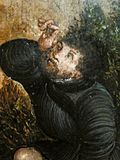This small wooden panel is possibly an engagement portrait of Princess Emilia of Saxony (1516 - 1591). In 1532, at the age of sixteen, she married Georg Hohenzollern, the second son of the Margave of Ansbach-Brandenburg. Saxony was a powerful German dukedom which traditionally appointed one of the seven Electors of the Holy Roman Emperor. Ansbach, although a smaller state, was growing in importance through successful alliances and advantageous marriages. Georg (1484 - 543), in addition to being a Hohenzollern was related to the Hapsburg family through one grandmother. He was also related to Emilia through his other grandmother, Anne of Saxony. The marriage was presumably beneficial to both families.
The picture may have been painted some years before Emilia’s marriage. It was not uncommon at this time for both royalty and the aristocracy to betroth their children to potential allies whilst they were still very young. The actual marriage would take place when children reached maturity. The portrait becomes therefore almost a legal record of the betrothal.
Husband and wife portraits were often painted in pairs. It is possible that there was a matching picture of Georg that is now lost. However in such pairs of portraits it is usual for the wife to face to left or right as though looking towards her spouse. Emilia’s very direct frontal gaze suggests that this was a single commission and not one of a pair. In the unromantic, calculating brokering of dynastic advantage that surrounded the union of Emilia and Georg, is it possible that her beloved kept the picture whilst he awaited her growth to maturity?
There are several symbolic indications in the portrait of Princess Emilia's engagement and of her impending absorption into her future husband’s family. On her bodice there are a pair of clasped hands, indicative of love. It has also been suggested that it is possibly the badge or insignia of a religious fraternity or brotherhood to which her future husband Georg belonged. One of her necklaces is made of a series of rings that also include clasped hands. Another necklace includes enamel badges of the coat of arms of her husband interspersed with gold decorated bunches of wheat or corn that are suggestive of the hoped-for fertile outcome of the marriage. On her hat there are other metal - possibly silver - badges with her initials and those of her husband's title.
Princess Emilia is very fashionably dressed in this portrait. Her dress is made of rich brocade. Her high forehead - shaved to accentuate its prominence - was also fashionable. Her hat has a circle of very expensive black ostrich feathers.
Stylistically the portrait is very reminiscent of the portraits of Lucas Cranach the Elder (1472-1553) who was court painter to the Elector of Saxony from 1505. Cranach’s distinctive large-headed, high-foreheaded, narrow-shouldered smiling women became almost the standard type of female portraiture in parts of Germany and Austria during the first half of the 16th century. The style was carried on by Lucas’s two sons who also worked for various German courts. It is worth looking at the mythological painting by Cranach entitled ‘The Nymph of the Fountain’ which can be seen hanging on the opposite wall to this picture. The face of the nymph is similarly proportioned to that of Princess Emilia. A triple portrait by Lucas Cranach of Emilia, aged 19 and her sisters Sidonia and Sibylla was painted in 1535 and is now in the Kunsthistorisches Museum in Vienna. In the Vienna portrait Emilia wears a similar large ‘figure of eight’ type of necklace to that in the Walker's picture.
Hans Krell (1490-1565), to whom this picture is attributed, was never as famous as his great contemporary Cranach. During his lifetime, however, he too enjoyed considerable patronage in both Bohemia and Germany. His ability to adapt his style to the dominant fashions in portraiture may have been advantageous.
In 1537 Emilia gave birth to Georg Friedrich Hohenzollern, who succeeded as Margave of Ansbach upon the death of his father in 1544 and also became Duke of Prussia in 1577. With his death in 1603 this older branch of the Hohenzollern family died out. The branch of the family that then came to prominence were subsequently rulers of Prussia and ultimately Kaisers of Germany.
The Walker’s picture, like several others from this period in the gallery, was originally owned by the Liverpool philanthropist, banker and scholar William Roscoe. Roscoe bought it in 1812 from a dealer for seven guineas, at which time it was entitled ‘A portrait of The Artist’s Wife’ by Lucas Cranach.
[1]






